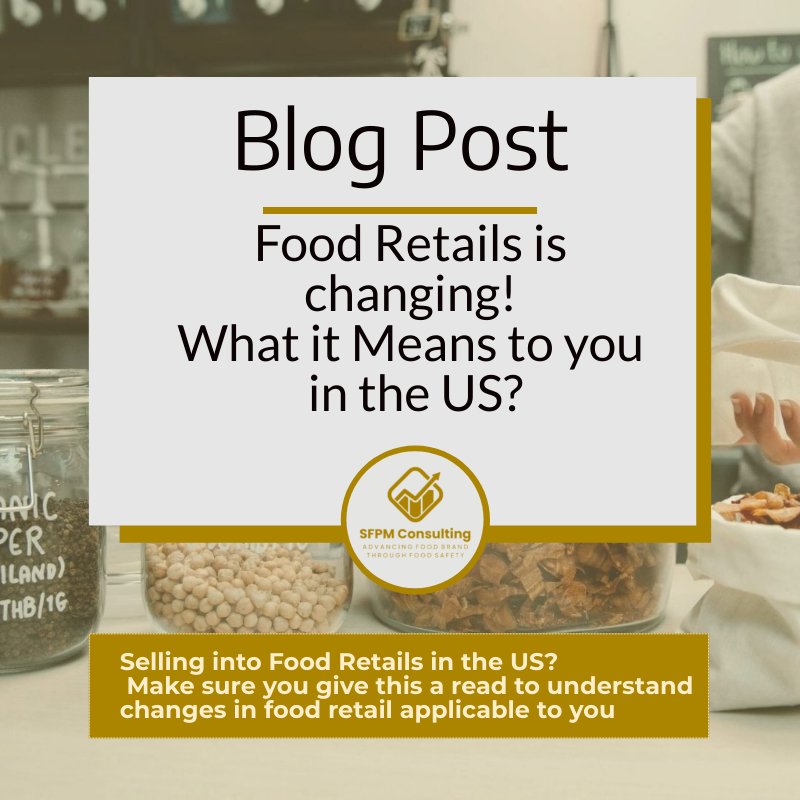Retail Modernization and FDA Blueprint Explained
In 2020, the FDA introduced the New Era of Smarter Food Safety Blueprint in order to incorporate technological advancements from the past decade into a modernized food safety regulatory framework.
One core element of this framework is the creation of new business models and retail modernization to meet the current needs of consumers. As we become more dependant on technology to meet our basic needs, and especially in response to the COVID-19 pandemic, the food industry has also turned to technology to address the needs of consumers. The sale of food via e-commerce has boomed within the last year with services such as grocery/food delivery and meal kits.
This blueprint will help to establish new FDA food safety regulations for food businesses following new business models such as e-commerce. The main objective of this core element is to address how to protect foods from contamination with these new business models emerging. Additionally, this core element of the FDA New Era of Smarter Food Safety Blueprint also focuses on modernizing the food safety technology of traditional restaurants and other food retail businesses.
This blog will highlight the principles of this core element in addition to how new business models are showing up in the food industry today and how you may see retail modernization in your own business.
The Principles
As explained by the FDA, new business models and retail modernization features two principles:
Ensure Safety of Food Produced or Delivered Using New Business Models
There has been a boom in the food delivery industry as a result of stay-at-home orders in response to the COVID-19 pandemic. But how do we ensure the safety of this food? The FDA suggests providing education for both the food delivery company regarding proper food handling and the consumer concerning time/temperature considerations and creating a food safety culture within the home.
As for existing food establishments, ensuring food safety concerns what approaches businesses can take to ensure food safety. This includes encouraging the use of technology that will measure product risks including time, temperature, and traceability information.
Modernize Traditional Retail Food Safety Approaches
This principle focuses on incorporating the technological advances we have seen over the last decade into food safety approaches. The FDA proposes a review of traditional food safety approaches and the effectiveness to food-borne illnesses as well as advancing the designs of equipment in traditional facilities.
The FDA also suggests enhancing food handling education as well as further research into strengthening retail food safety.
What this could look like in your business: New FDA food safety regulations for new food Businesses?
With this blueprint in place, the FDA is looking to address new business models to identify potential food safety vulnerabilities and courses of action to prevent them. There are many new business models emerging in the food industry such as e-commerce.
Many restaurants have already started to offer delivery through services such as UberEats and Skip the Dishes in order to continue operating during the pandemic. Similarly,”ghost kitchens” which are food prep operations without wait staff or dining rooms that prepare food for solely for delivery or takeout have emerged. In the future, owners of such businesses may require those working for them such as delivery drivers to undergo training for proper food handling and for any other food safety issues that may come up.
Additionally, many companies are shipping their food products in addition to or instead of selling their products through a storefront. It is suggested by the FDA that delivery services such as UPS and FedEx also undergo similar food safety training as delivery drivers.
E-commerce food businesses may have different regulations than food businesses following traditional models. To learn more about possible regulations for your food business, refer to our blog about e-commerce food businesses.
Retail Modernization
The FDA’s New Era of Smarter Food Safety Blueprint looks to utilize the full power of technology to further protect food businesses and consumers from food safety hazards in traditional food retail businesses. If you are an owner of a traditional business model, this means your food safety practices could become much more digitized.
Equipment is said to be advanced with more preventive controls and the FDA encourages the use of smart kitchen equipment with features such as automatic monitoring of time and temperature. New equipment and tools could even include digital tools to incentive food safety behaviours such as hand washing and manual temperature monitoring.
Lastly, those working in the food industry can expect advancement in food handling education requirements.
References
Center for Food Safety and Applied Nutrition. (n.d.). New Era of Smarter Food Safety Blueprint. U.S. Food and Drug Administration. https://www.fda.gov/food/new-era-smarter-food-safety/new-era-smarter-food-safety-blueprint.
Newpapers, Miller,Jeffrey. L. (2021, July 3). What’s a ghost kitchen? A food industry expert explains. Greensboro News and Record. https://greensboro.com/community/rockingham_now/news/whats-a-ghost-kitchen-a-food-industry-expert-explains/article_184cf9ba-dc13-11eb-be07-434bc768a2ef.html.

